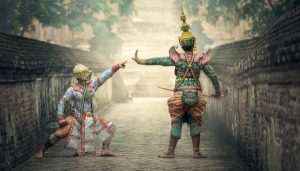
The historic provinces of the Iga and the Koka, located in the modern Mie and Shiga prefectures respectively, formed the first known strongholds of the ninja. The mountainous regions, interspersed by babbling brooks and grassy glens, holds the secrets of the famous ninja clans. Many researchers have dedicated their lives to unraveling the mysteries behind the ninja by traveling to the provinces. By studying the historic remnants of the Koka and Iga, both academics and the public glean important insights into the life of a shadow warrior.
Both the Iga and Koka developed abilities that became synonymous with ninjas during Japan’s Kamakura period. The emergence of small, rural domains within the Iga and Koka provinces caused a constant state of friction between neighbors. The resulting guerrilla wars fought within the mountains allowed the Iga and Koka to hone their abilities in espionage, deception, stealth, assassination, and other covert operations. These skillsets were eventually complied into the famous Iga-ryu and Koka-ryu ninjutsu lineages. Ninjas from the koka and Iga provinces spent most of their time farming, woodcutting, or traveling as monks. Only when necessary would they utilize their covert skillsets to dispatch enemies or gather intelligence.
During the Muromoachi period, the Iga and Koka unfettered themselves from feudal lords altogether. Instead of deferring to central regimes, they formed their own republics with small councils of representatives to ensure cooperation and fair governance. An amicable relationship developed between the Koka and Iga and they would work together several times to repel armies encroaching on their territories. Their independent nature, however, would soon grate against the expansionist policy of great Oda Nobunaga. The clash would lead to the defeat of the Iga during the Tensei Iga War, which unintentionally had the effect of dispersing the feared Iga-ryu and Koka-ryu traditions across Japan as the surviving ninjas fled their homeland.
Today, the provinces attract thousands of tourists eager to walk amongst the houses where ninjas trained and lived. Demonstrations conducted by modern practitioners of ninjutsu provide a glimpse into the past; from walking on water, to hand-to-hand combat, to shuriken throwing. Other attractions include historic ninja houses: The almost 300 years old Koka Ninja house contains numerous devices and traps to confound interlopers and allow the owner to remain hidden. Visitors are also encouraged to visit the beautiful Ninja Museum of Igaryu, which contains both historic ninjutsu writings and hundreds of ninja weapons.
While the traditions of the ninja extend beyond the Koka and Iga provinces to other regions of Japan, these two provinces formed the heartland of ninjutsu for a considerable time. Both literary and archaeological evidence support claims that the region specialized in ninjutsu thanks to years of developing effective combat and stealth techniques in the mountains. By producing many talented ninjas of legendary status, such as Hattori Hanzo and Momochi Tambanokami, the Iga and Koka provinces secured their places in ninjutsu history.




Free 2-Day Shipping!
all USA orders